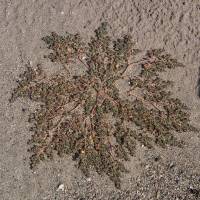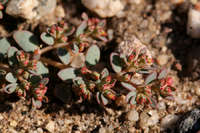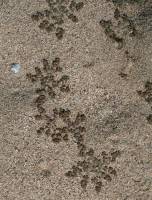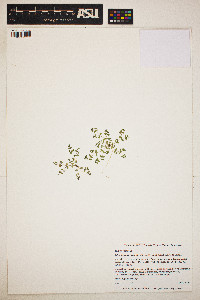Kearney and Peebles 1969, McDougall 1973, FNA 2016, Allred and Ivey 2012
Duration: Annual Nativity: Native Lifeform: Forb/Herb General: Mat-forming annual herbs, from slender taproots; stems prostrate, 5-25 cm long; herbage glabrous to shortly pilose. Leaves: Opposite along the stems, on short petioles 1 mm long; blade ovate to oblong, 6-15 mm long, with an asymmetric base and entire margins; stipules tiny (less than 0.5 mm long), distinct, and subulate (narrowing toward the top). Flowers: Has the highly modified flower structure characteristic of Euphorbias. Structures called cyathia appear to be individual flowers, but are composed of fused-together bracts forming a cup (involucre), with peripheral nectary glands which are often subtended by petal-like bracts called petaloid appendages. Within the cup there is a ring of inconspicuous male flowers, each reduced to a single stamen. Out of the middle protrudes a single, stalked female flower which lacks petals. In E. micromera, the cyathia (flower structures) are solitary in leaf axils near branch tips; Involucres are bell-shaped, 0.5 mm high, and glabrous or pilose (covered with long soft hairs) with 4 round red glands around the edge and no petaloid appendages; 2-5 staminate flowers. Fruits: Capsules oblong, 3-celled, 1.5 mm high and usually glabrous; containing 3 light gray, narrowly ovoid seeds, 1 mm high, 4-angled in cross section, smooth to slightly wrinkled (rugose) or with 1–4 faint transverse ridges that do not pass through abaxial kee Ecology: Found on flats, washes, bajadas, and hillsides from 500-5,000 ft (152-1524 m); flowers throughout the year. Distribution: c and s CA, NV, s UT, AZ, NM, s TX; south to c MEX. Notes: This species belongs to the Chamaesyce subgenus of Euphorbia. Some treatments, even recent ones, continue to treat Chamaesyce as a separate genus even though molecular evidence places it within Euphorbia. Chamaesyce spp are distinct based on their leaves which are always opposite and and often have asymmetric bases; cyathia (flower structures) in leaf axils, not at branch tips, and usually with petaloid appendages; and stipules present and not gland-like. E. micromera is one of the more delicate Chamaesyces in the region; distinguished by being an annual completely prostrate and hugging the ground; foliage mostly glabrous or sometimes with a few short straight hairs; the opposite, oval, entire leaves less than 15 mm long, with asymmetric bases; solitary, un-clustered inflorescences; no petaloid appendages on cyathia (flower-like structures); hairy ovaries and smooth seeds. It is wise to make a collection whenever ID to species is needed, as Chamaesyces are difficult to identify in the field, and multiple species of the genus will commonly grow side-by-side. Ethnobotany: Unknown Etymology: Euphorbia is named for Euphorbus, Greek physician of Juba II, King of Mauretania; micromera is from the Greek mikros, small, and meros, parts. Synonyms: Chamaesyce micromera Editor: SBuckley 2010, FSCoburn 2015, AHazelton 2017









